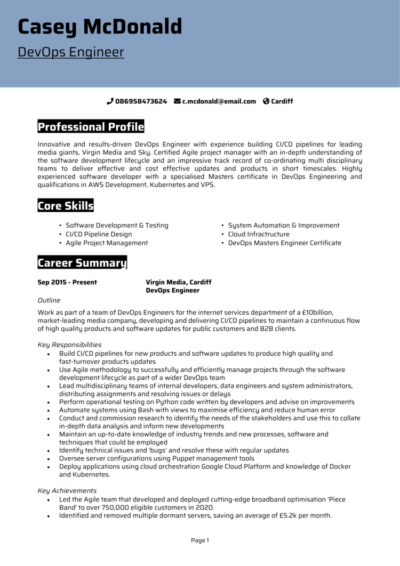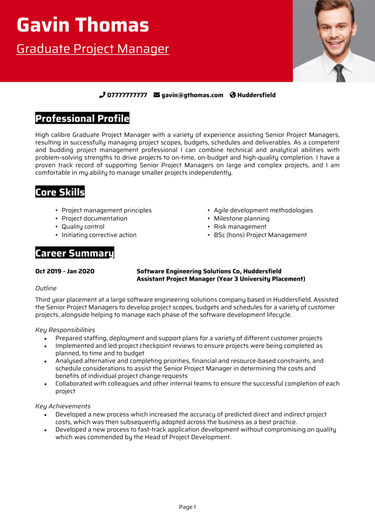Whether you’re automating infrastructure or resolving production issues at 3 a.m., your role as a DevOps Engineer is all about reliability and seamless delivery.
To help crack the code of a perfect CV, use this guide and its 2 DevOps Engineer CV examples and properly show off your technical expertise, so you can land your next high-impact role.
DevOps Engineer CV example
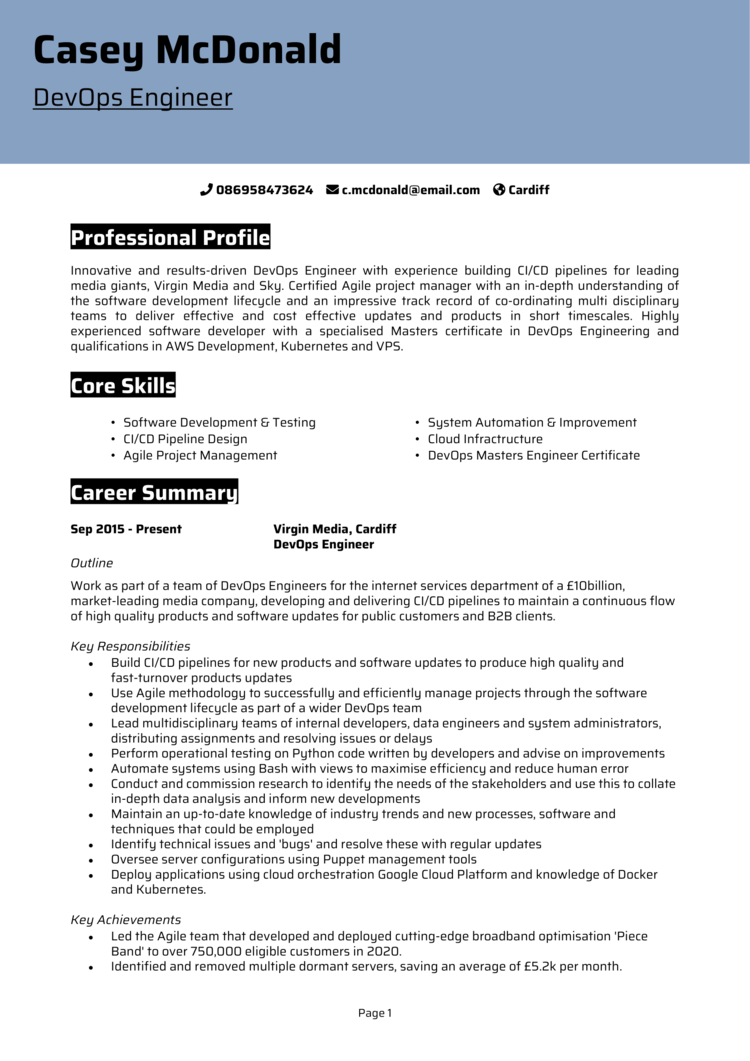
Junior DevOps Engineer CV example

How to write your DevOps Engineer CV
Discover how to craft a winning DevOps Engineer CV that lands interviews with this simple step-by-step guide.
In DevOps, clarity and performance are everything – your CV should be no different. Employers are looking for engineers who can code, automate, monitor, and collaborate – without overcomplicating the message.
This guide will go step-by-step through writing your CV that doesn’t just list tools – it demonstrates how you’ve used them to improve processes and reduce downtime in order to deliver consistent results.
How should you structure and format a DevOps Engineer CV?
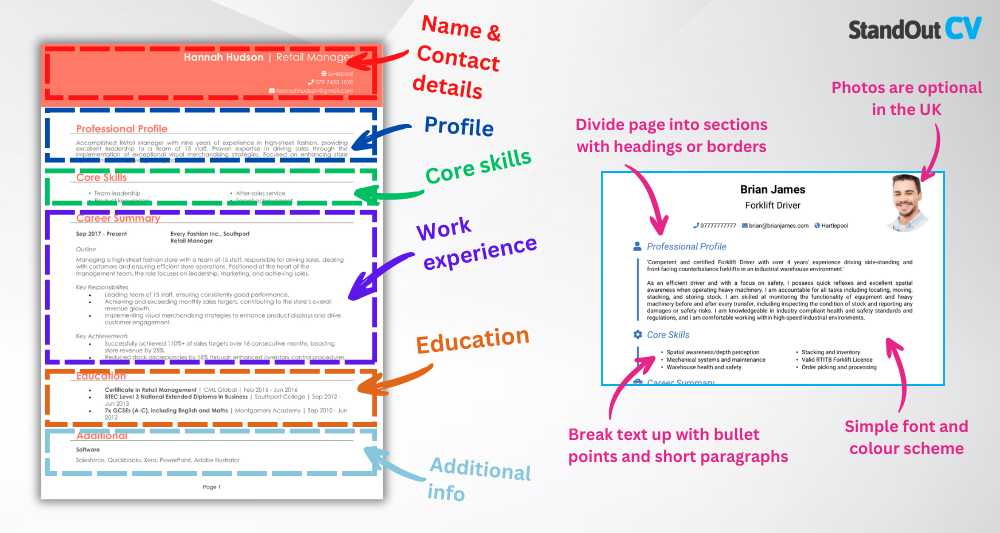
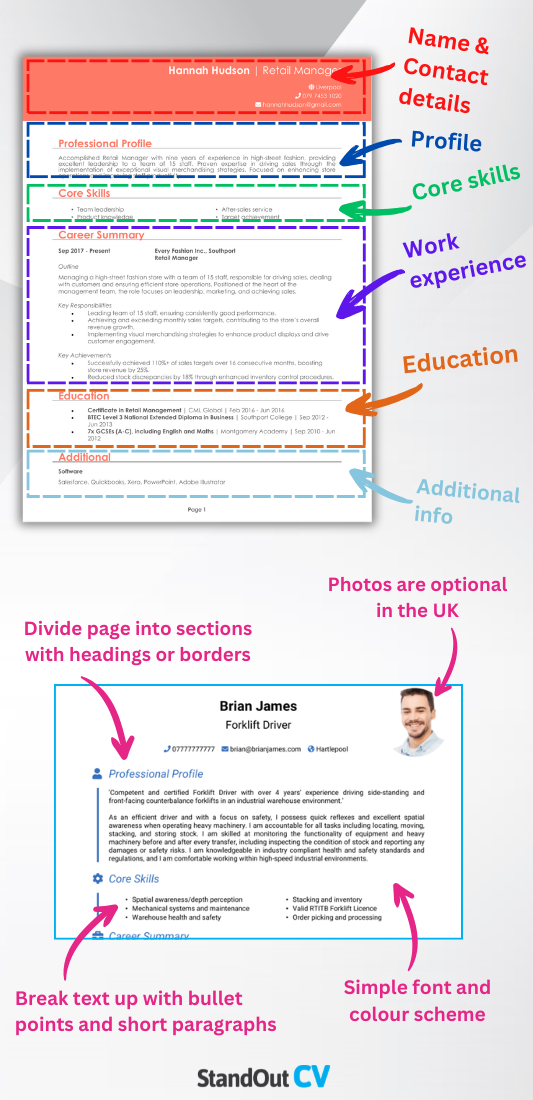
A strong DevOps CV should be just as clean and reliable as the systems you help maintain. Recruiters want to quickly see what technologies you’ve worked with, what environments you’ve supported – and the impact you’ve made in them.
Here’s how your CV should be laid out:
- Name and contact details – Display your contact details clearly at the top so employers can get in touch easily. Including a photo is entirely optional..
- Profile – Begin with a short, high-level summary of your experience, tools, and areas of focus.
- Core skills – Highlight your top technical proficiencies and relevant soft skills.
- Work experience – List roles in reverse chronological order, focusing on achievements and infrastructure impact.
- Education – Mention your degree, certifications, and any training that supports your career path.
- Additional info – Include any additional details, like awards, professional memberships, or hobbies and interests that highlight your skills or personality.
Use bullet points to improve readability, divide sections with clear headings, and stick to a clean, readable font. Keep your CV no more than two pages long – concise, but packed with relevance. Following these simple, helpful tips for your CV formatting will ensure the focus stays on your expertise, not any visual errors.
Writing a DevOps Engineer CV profile
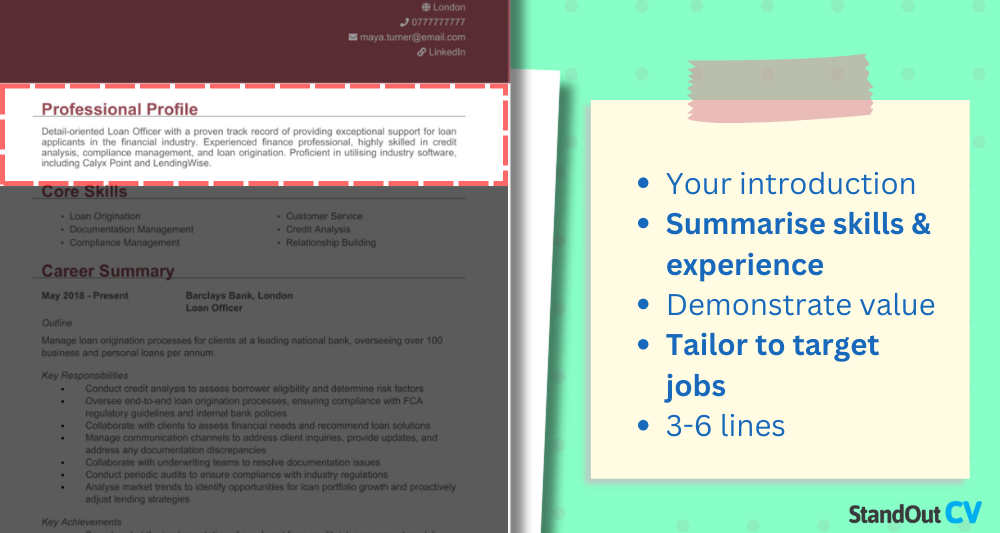
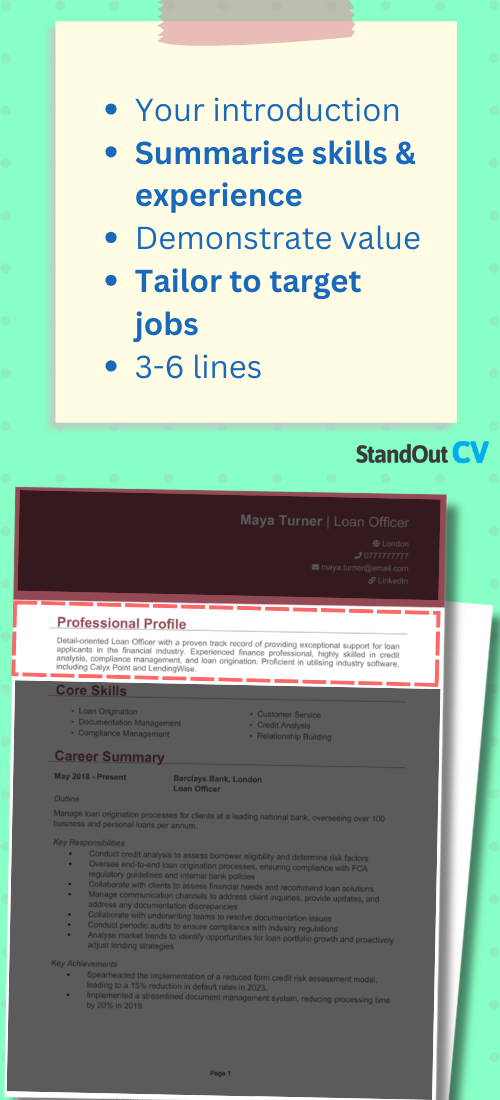
Your CV profile acts as a high-level summary of your career so far – an introduction that lets recruiters quickly understand your background and technical focus. It should position you as someone who not only understands the DevOps lifecycle but can actively improve it, from deployment efficiency to infrastructure scalability.
This section is also your opportunity to reflect the type of roles you’re aiming for and the environments you thrive in – whether that’s fast-moving start-ups, enterprise systems, or security-focused platforms.
DevOps Engineer CV profile examples
Profile 1
Experienced DevOps Engineer with over five years of hands-on work in automating infrastructure, managing containerised applications, and enhancing system security. Skilled in cloud-native technologies and microservices architecture. Proficient in Ansible, Helm, and Kubernetes administration. Passionate about improving development efficiency through robust automation and continuous improvement.
Profile 2
Skilled DevOps Engineer with four years of experience automating deployment pipelines, managing cloud infrastructure, and supporting CI/CD workflows. Proficient in tools such as Jenkins, Docker, Kubernetes, and Terraform. Experienced in AWS and Azure environments, with a strong focus on system reliability, performance optimisation, and infrastructure as code. Committed to delivering scalable and resilient solutions through collaboration and automation.
Profile 3
Results-driven DevOps Engineer with three years of experience supporting software development teams by streamlining operations, integrating DevOps practices, and reducing deployment times. Proficient in scripting languages like Python and Bash, as well as CI/CD tools such as GitLab CI and CircleCI. Strong background in monitoring and observability using Prometheus, Grafana, and ELK stack.
Details to put in your DevOps Engineer CV profile
Here’s what to put in your CV profile:
- Career background – Give a brief summary of your DevOps or relevant IT experience.
- Tech environment – Reference the general tools, platforms, or cloud providers you’ve worked with – without getting into granular lists.
- Working style – Highlight your approach to collaboration, automation, or systems thinking.
- Industry exposure – Mention the sectors or types of teams you’ve supported.
- Career direction – Indicate your focus or interests moving forward.
Writing an effective core skills section
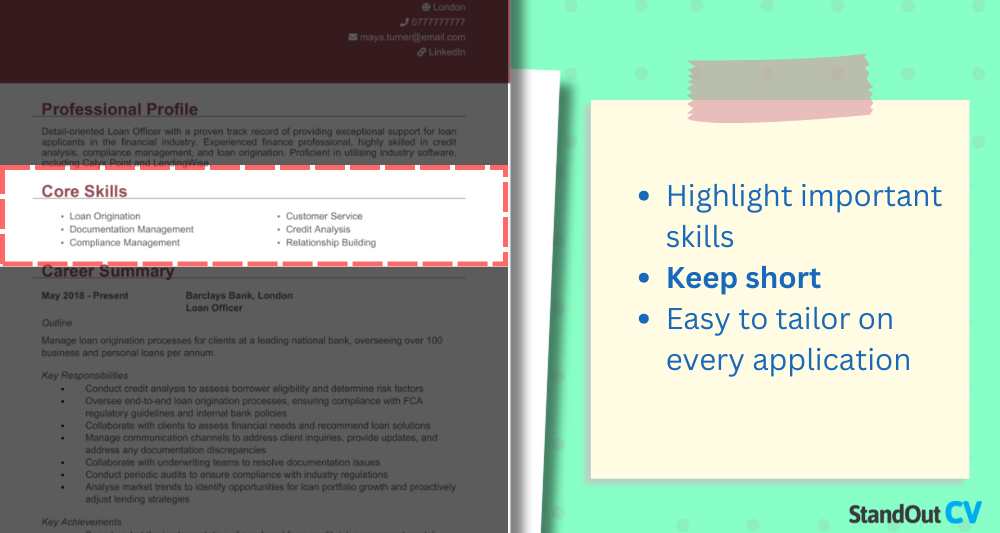

The core skills section offers a quickfire overview of your strengths as a DevOps professional. Rather than listing every tool you’ve ever touched, focus on highlighting the areas where you bring the most value – tailored to the job you’re applying for.
This section is a great opportunity to align your experience with the employer’s priorities, whether that’s rapid deployment, infrastructure automation, system reliability, or team integration. Keep your bullet points concise and relevant, making it easy for recruiters to recognise your fit at a glance.
The top skills to highlight in your DevOps Engineer CV
- CI/CD Pipeline Implementation – Designing and managing continuous integration and deployment pipelines using tools like Jenkins, GitLab CI, or CircleCI.
- Infrastructure as Code (IaC) – Automating infrastructure provisioning and configuration with tools such as Terraform, Ansible, or CloudFormation.
- Cloud Platform Management – Deploying, monitoring, and scaling applications on platforms like AWS, Azure, or Google Cloud.
- Containerisation and Orchestration – Using Docker and Kubernetes to build, deploy, and manage containerised applications efficiently.
- Monitoring and Logging – Implementing tools like Prometheus, Grafana, ELK Stack, or Datadog to monitor system performance and troubleshoot issues.
- Version Control and Git Workflow – Managing code changes and collaboration using Git, GitHub, GitLab, or Bitbucket.
- Security and Compliance Automation – Integrating security tools and practices into the DevOps pipeline to ensure secure deployments.
- Scripting and Automation – Writing scripts in Bash, Python, or PowerShell to automate routine tasks and workflows.
- System Administration – Managing Linux or Windows servers, performing updates, backups, and ensuring system reliability.
- Collaboration and Agile Methodologies – Working closely with development, QA, and operations teams in Agile or Scrum environments to deliver high-quality software.
Showcasing your work experience
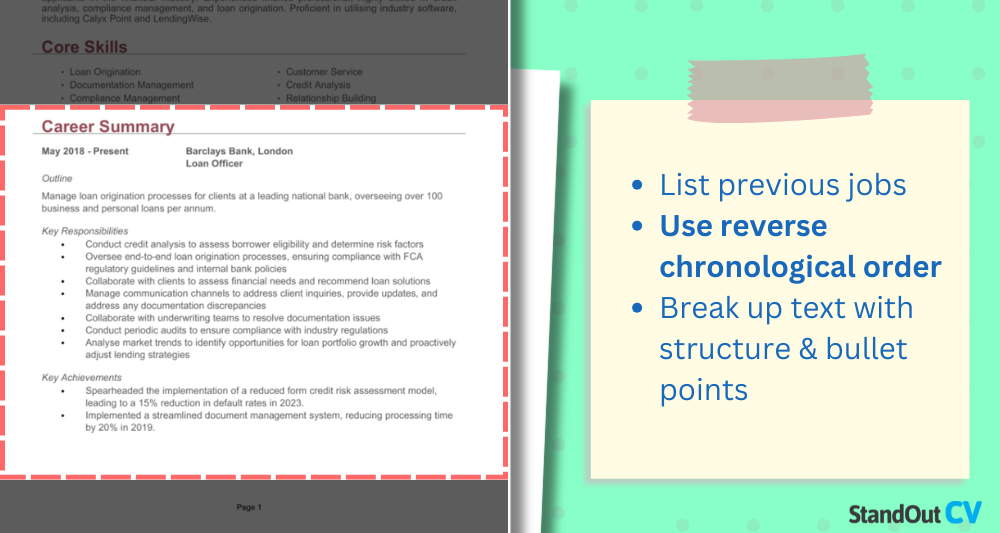
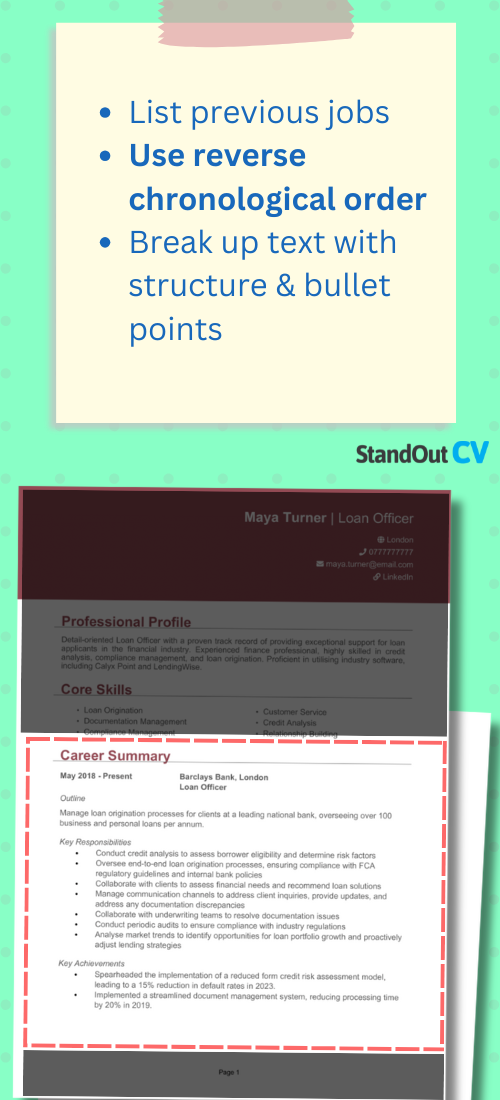
DevOps roles are all about implementation and impact – so your work experience section should reflect more than just your responsibilities. Recruiters want to see the outcomes of your work: faster deployments, lower error rates, improved availability, and happier development teams.
Structure this part with your most recent role first, and work backwards. Focus on technical environments, collaboration with dev and QA teams, and tools you’ve deployed. If you’re newer to DevOps, include related experience from systems engineering, software development, or IT support.
Writing job descriptions for past roles
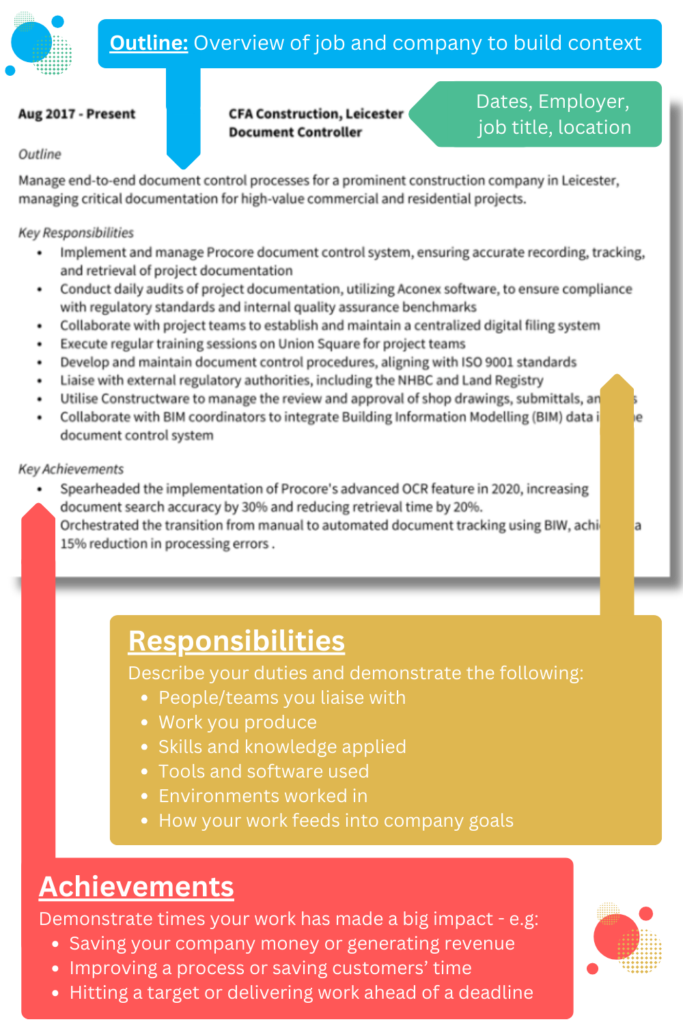
- Outline – Introduce the employer, size or scale of the tech team, and your role within it.
- Responsibilities – List what you managed or implemented, using action verbs like “automated,” “deployed,” and “maintained.”
- Achievements – Highlight measurable results like faster build times, improved uptime, or cost reductions.
How to present past roles for DevOps Engineer
DevOps Engineer | NovaCore Tech
Outline
Managed infrastructure and deployment automation for a SaaS product team at a mid-sized tech company, supporting cloud-native applications across AWS and Kubernetes.
Responsibilities
- Built and maintained CI/CD pipelines using Jenkins and GitHub Actions to support multiple development teams.
- Provisioned infrastructure using Terraform and managed configuration with Ansible.
- Monitored application performance using Prometheus and Grafana dashboards.
- Implemented container orchestration using Kubernetes, managing deployments and rollbacks.
- Worked closely with developers to integrate testing and deployment workflows.
Achievements
- Reduced deployment times by 60% by optimising CI/CD pipelines.
- Improved system uptime to 99.98% by introducing automated failover and scaling mechanisms.
- Saved infrastructure costs by 20% through resource allocation and usage analysis.
DevOps Engineer | Skyfold Systems
Outline
Supported cloud migration and automation processes for a large financial software provider, improving infrastructure scalability and deployment efficiency.
Responsibilities
- Led the migration of legacy infrastructure to AWS, including EC2, S3, and RDS services.
- Implemented automated deployments using CircleCI and Docker.
- Set up monitoring and alerting for cloud resources using CloudWatch and ELK stack.
- Maintained infrastructure as code using CloudFormation and Terraform.
- Collaborated with QA and development teams to integrate testing tools into the release pipeline.
Achievements
- Cut release cycle time from weekly to daily by introducing a fully automated CI/CD pipeline.
- Contributed to a successful ISO 27001 audit by documenting and enforcing secure deployment practices.
- Reduced deployment-related incidents by 40% through improved monitoring and rollback procedures.
DevOps Engineer | ByteCraft Digital Solutions
Outline
Oversaw cloud infrastructure and DevOps strategy for a digital agency working with high-traffic e-commerce platforms and enterprise clients.
Responsibilities
- Developed reusable Helm charts for Kubernetes deployments across multiple environments.
- Created Bash and Python scripts for task automation and configuration updates.
- Maintained GitOps workflows and ensured version control of all infrastructure changes.
- Managed access control, SSL certificates, and secrets using HashiCorp Vault.
- Optimised system performance by tuning container resource usage and load balancing.
Achievements
- Improved deployment consistency and reduced manual errors by introducing GitOps practices.
- Enabled zero-downtime deployments across all client-facing services.
- Received recognition from clients for improving deployment reliability during peak traffic periods.
Highlighting your education
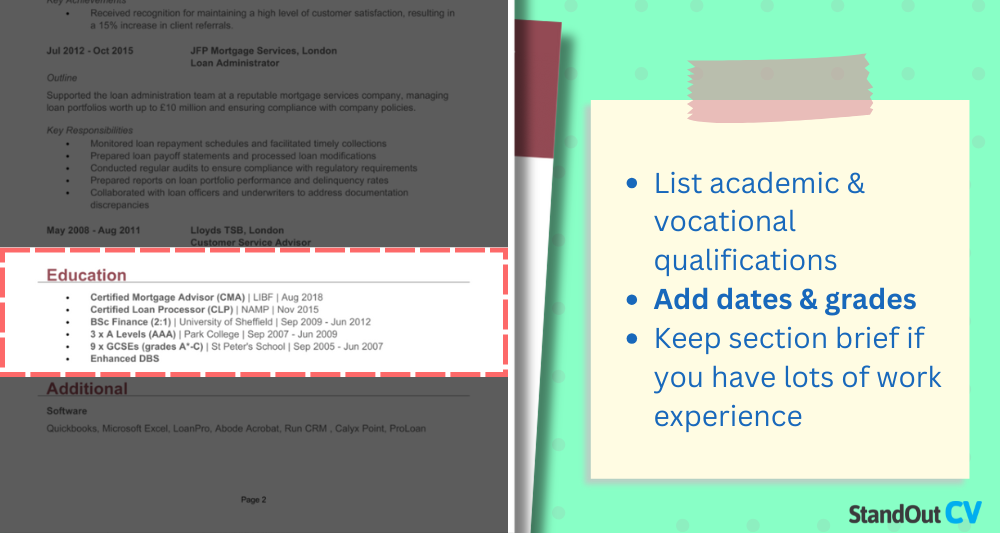

A strong foundation in computing or engineering goes a long way in DevOps – but so does continuous upskilling. Include any degrees in computer science or related fields, and list industry certifications clearly.
If you’ve earned relevant cloud, container, or DevOps-specific certifications, note them here. If you’re self-taught or have completed bootcamps, short courses, or platform-specific training, these are worth including too. Your education section should ideally be short, as you should keep the focus on your experience.
The best qualifications to boost a DevOps Engineer CV
- Bachelor’s Degree in Computer Science, Engineering, or IT – A strong foundation for infrastructure and systems thinking.
- AWS Certified DevOps Engineer – Professional – Highly regarded in cloud-based roles.
- Microsoft Certified: Azure DevOps Engineer Expert – Key for roles focused on Microsoft cloud environments.
- Certified Kubernetes Administrator (CKA) – A valuable credential for container orchestration roles.
- HashiCorp Terraform Certification – Useful for infrastructure-as-code-based roles.


